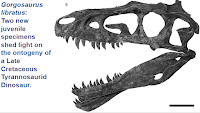The Ornithomimosaurs are a group of Theropod Dinosaurs with notably long and slender hindlimbs, thought to have been capable of sustained high-speed running in a similar fashion to modern Ostriches. This Ostrich-like appearance is accentuated by their having feathers, long necks, small heads, and often-toothless beak-like jaws. The earliest known Ornithomimosaurs date from the Early Cretaceous, with the two major subdivisions of the group, the Ornithomimidae and Deinocheiridae apparently having already diverged by this time, implying a deeper 'ghost' history to the clade, which has not been detected in the fossil record.
In a paper published in the journal Scientific Reports on 7 September 2023, Soki Hattori, Masateru Shibata, Soichiro Kawabe, Takuya Imai, Hiroshi Nishi, and Yoichi Azuma of the Institute of Dinosaur Research at Fukui Prefectural University, and the Fukui Prefectural Dinosaur Museum, describe a new species of Ornithomimosaur from the Early Cretaceous Kitadani Formation exposure at Kitadani Dinosaur Quarry.
Kitadani Dinosaur Quarry is a notable Dinosaur-producing site in Fukui Prefecture, which has previously produced a number of new Dinosaur species, including the Therizinosaur, Fukuivenator paradoxus, which is the most complete non-Avian Dinosaur known from Japan, the Titanosaur, Fukuititan nipponensis, the Megaraptor, Fukuiraptor kitadaniensis, and the Iguanodontian, Fukuisaurus tetoriensis.
Bonebed 1 is a distinct layer within the Kitadani Formation at Kitadani Dinosaur Quarry containing a large number of disassociated Dinosaur bones interpretted as having come from a single species of Ornithomimosaur, which Hattori et al. formally describe as a new species, under the name Tyrannomimus fukuiensis, where 'Tyrannomimus' refers to the similarity of the species to some (small) Tyrannosaurs, in particular its possession of a vertical ridge on the ilium, a feature previously interpreted as a defining Tyrannosaur trait, and 'fukuiensis' means 'from Fukui'.
Tyrannomimus fukuiensis is described from a holotype, FPDM-V-11311, a disarticulated but associated skeleton including two parts of the braincase, several dorsal, sacral and caudal vertebrae, and fragments of ilium, and paratype, FPDM-V-10295, a disarticulated but associated hindlimb skeleton including a partial lef femur, left metatarsal II, lef and right metatarsal IV, right pedal phalanx I-1 and a pedal ungual, with reference to several other specimens.
Bonebed 1 contains a very large number of detached bones, but this appears to be a monospecific assemblage, with little variation among any of the individual skeletal elements. The holotype of Tyrannomimus fukuiensis does not appear to be fully mature, which might raise the possibility that it is a juvenile of another species, notably Fukuiraptor kitadaniensis, which is also present at Kitadani Dinosaur Quarry and of nearly identical age. However, the holotype of Tyrannomimus does not show any of the diagnositic features of Fukuiraptor, while it shows a number of diagnostic features of the Ornithomimosaurs and is clearly monospecific with the other material from Bonebed 1, effectively ruling out such a hypothesis.
A phylogenetic analysis recovered Tyrannomimus fukuiensis as a member of the Deinocheiridae, forming a sister taxon to the Mongolian Harpymimus okladnikovi. This analysis also makes Tyrannomimus fukuiensis the oldest known member of the Deinocheiridae, and the first member of that group from East Asia. This close relationship between the Japanese Tyrannomimus fukuiensis and the Mongolian Harpymimus okladnikovi is noteworthy, as other Early Cretaceous Japanese fossils, including Hadrosaurs and Cockroaches have also shown closer affinity to Mongolian groups than to Chinese ones, suggesting an ecological link between the two areas.
The presence of a vertical ridge on the ilium of Tyrannomimus fukuiensis makes it very similar to the ilium of Aviatyrannis jurassica, a Theropod Dinosaur from the Late Cretaceous of Portugal, currently assumed to be a Tyrannosaurid, largely due to the possession of this feature. Aviatyrannis jurassica has a number of other features, such as a brevis fossa which becomes mediolaterally broader towards the posterior end, which are typical of Ornithomimosaurs. A phylogenetic analysis of the Ornithomimosauria with Aviatyrannis jurassica included recovered this Jurassic 'Tyrannosaur' as the sister taxon to Tyrannomimus fukuiensis. If this is correct then Aviatyrannis jurassica is in fact both the earliest known Ornithomimosaur and the earliest known Deinocheirid, although without having inspected the holotype of Aviatyrannis jurassica themselves, Hatorri et al. are cautious in this assessment.
Online courses in Palaeontology.
Follow Sciency Thoughts on Facebook.
Follow Sciency Thoughts on Twitter.










